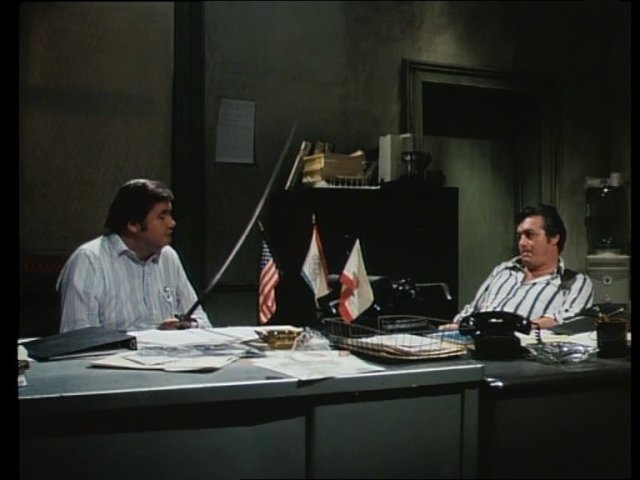
Well, I thought that I’d talk about whether or not a bad ending can actually ruin a good film or not. This was something I ended up thinking about in mid-October last year when I finally got round to watching a second-hand DVD of Stu Segall’s 1976 horror/detective film “Drive-In Massacre”.
Obviously, this article will contain MAJOR PLOT SPOILERS for this film.
Set in 1970s California, the film focuses on two detectives who are trying to catch a sword-wielding serial killer who is terrorising a local drive-in theatre, built on the site of an abandoned carnival. Whilst it is very much a low-budget vintage B-movie, the film was – mostly – a much better film than it has any right to be.
The blend of detective and horror elements is handled surprisingly well, with the detectives’ investigations leading them to meet some genuinely creepy characters as well as occasionally placing them in nerve-wracking suspenseful situations (like the “warehouse” scene, which was scarier than I expected!).
The mystery is genuinely compelling, since there’s no shortage of suspects and plenty of red herrings. There are also hints of the chaotic – but realistic – stories of old 1930s-50s hardboiled detective novels. The ending – which I’ll discuss later – is more like a horror movie ending than a detective movie ending, but the build-up to it is very much in the detective genre.
The two detectives are genuinely likeable characters. Whilst they get into one gunfight and one chase, they aren’t action heroes or grizzled “film noir” detectives. They’re two portly middle-aged men who seem like genuinely nice guys.
They are tough when they have to be but don’t try to be “tough guys” just for the sake of it. They have emotions – albeit expressed in an understated way. They can be friendly, sarcastic or curious. They fail and make mistakes sometimes. They work as a team. They have a sense of humour, but aren’t comedy characters. Like, they actually seem like realistic men rather than idealised cartoon characters.

Seriously, these detectives are more well-written characters than you might expect from a low-budget 1970s B-movie.
And that’s what’s so good about the film, it feels… human… in a way that Hollywood movies don’t always do. Like, yes, the premise is stylised and goofy, but the characters actually seem like real people because virtually all of them get at least some characterisation. The acting is better than you’d expect, and you’re just as likely to pity some characters as you are to be scared by some characters. It’s really difficult to describe, but – again – the film just felt more “human” than I’d have expected from a corny 1970s B-movie.
The film was more gruesome than I expected, but in a very mildly understated way – compared to modern splatter movies – which actually makes it shocking, rather than cartoonish. It also has this wonderfully “1970s America” atmosphere to it, like a more cynical and run-down version of 1960s America.
And the film also gets the balance between nihilistic cynicism and emotional satisfaction weirdly right as well – the case seems confusing, depressing and senseless – like in an old hardboiled novel – but there are enough likeable and/or human moments to give the film a “heart” at the same time.
But then there’s the ending. To be fair, if you watched this film in a US drive-in theatre during the 1970s, then the ending would be brilliant. In it’s original context, it’s actually a really clever ending. But it literally only “works” in this one context.
It’s a vaguely William Castle-esque gimmick ending where, just when the detectives are closing in on the last two suspects… they find them both dead and the killer nowhere to be seen. A corny voice-over then warns the audience that the killer is still at large… and may be lurking in YOUR drive-in theatre! It’s a “goofy old horror movie ending” turned up to eleven!
Yet, the ending has enough ambiguity that – had they left out the voice-over – it would have actually been a good ending. You only directly see the body of one suspect, with the rest of the scene being implied via silhouettes.
I genuinely thought that the other suspect was the killer for a moment… but then the voice-over appears and ruins this eerie ambiguity, which fits perfectly into the more “realistic” hardboiled atmosphere that the film is going for. It’s a dreadful way to end a surprisingly good film.
Still, surprisingly, I don’t regret watching it. Whilst I was disappointed by the ending, the rest of the film was still this atmospheric, suspenseful and compelling thing that I seriously enjoyed watching. The characters and atmosphere were a lot better than I expected too. It is a film which has more humanity to it than I expected. And, as cliched as it sounds, sometimes the journey can be better than the destination. And it’s probably better to have a good film with a bad ending, than a bad film with a good ending.
In simple terms, it’s the difference between tens of minutes of satisfying entertainment and just one minute (or less) of satisfying entertainment. So, no, a bad ending can’t entirely ruin an otherwise good film.
————————-
Anyway, I hope that this was interesting 🙂